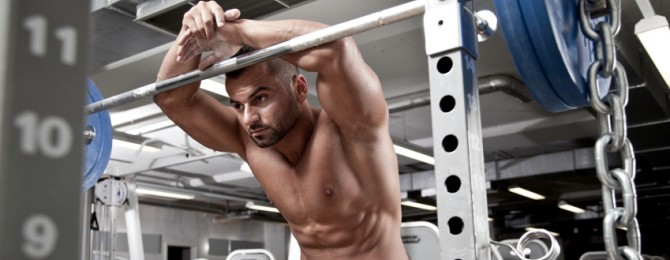What is the optimal rest period between sets to grow muscle faster? Two studies debunk the myth of shorter rest periods between sets as being optimal.
Most training programs are designed around the belief that in order to build strength and muscle size largely depends on load, progression, time under tension, nutrition and rest periods.
It’s common knowledge in fitness communities across the world that to build strength you need longer rest periods (3-5 minutes) and to build muscle size you need shorter rest periods (30-90 sec).
While these rest periods have their place in various training programs, short rest periods are not as necessary as one might think in order to grow muscle size.
Does Shorter Rest Periods Produce Two of The Three Mechanisms to Muscle Growth i.e. Metabolic Stress and Muscle Damage?
The 3 Mechanisms To Muscle Growth
Recent research has discovered that there are 3 primary mechanisms to muscle growth:
- Mechanical Tension (Lifting heavy using progressive overload)
- Metabolic Stress (Creating micro-tears in the muscle fibers which has to repair)
- Muscle Damage (Reaching the lactic threshold for releasing testosterone)
Out of the 3, mechanical tension is the most important one by using progressive overload.
Progressive overload over time produces strength by using heavier weights each time you hit the gym.
Shorter rest periods do create metabolic stress and muscle damage, but if that comes at the expense of making slower strength gains you are actually not training optimally.
You are compromising the primary driver of growth, strength.
Eric Helm states, “It is well established that using very short rest intervals can reduce the number of repetitions that can be performed on subsequent sets. Thus, if you restrict rest periods for the purpose of increasing metabolic fatigue to the point where you perform less total repetitions, or have to use lighter loads on subsequent sets, you are essentially “throwing the baby out with the bathwater”. Meaning, you have sacrificed total volume for metabolic fatigue.”
As you can see, it’s not really worth sacrificing overall strength to create metabolic stress and muscle damage.
How Do You Create Metabolic Stress and Muscle Damage WITHOUT Short Rest Periods?
To answer that question, we first need to understand that there is no correlation to the amount of weight you lift in order to produce muscle size.
Both metabolic stress and muscle damage are produced when using the right amount of “time under tension”
Muscles do not know how much weight you are lifting, it only responds to tension and stress.
Creating the right amount of tension requires that you reach the lactic threshold responsible for producing the male hormone testosterone.
You’ll know when you reach the lactic threshold when you are unable to perform any more reps in that set. This is commonly called, “Training to Failure.”
The point?
Creating metabolic stress and muscle damage has nothing to do with rest periods, but everything to do with how you perform the set:
- Using the proper time under tension
- Reaching the lactic threshold to produce testosterone
- Training to failure
So…How Long to Rest Between Sets For Recovery and Muscle Growth (2 studies)
Study #1
Twenty-one young resistance-trained men were randomly assigned to either a group that performed a resistance training (RT) program with 1-minute rest periods or a group that employed 3-minute rest periods.
The study lasted 8 weeks with subjects performing 3 total body workouts a week comprised 3 sets of 8-12 repetition maximum (RM) of 7 different exercises per session.
Testing was performed pre-study and post-study for muscle strength (1RM bench press and back squat), muscle endurance (50% 1RM bench press to failure), and muscle thickness of the elbow flexors, triceps brachii, and quadriceps femoris by ultrasound imaging.
The Results?
Maximal strength was significantly greater for both 1RM squat and bench press for LONGER rest periods compared to SHORTER ones.
Muscle size and thickness was also significantly greater for LONGER rest periods compared to SHORTER ones in the anterior thigh, and a trend for greater increases was noted in the triceps brachii as well.
Conclusion?
Both groups saw significant increases in local upper body muscle endurance with NO significant differences noted between groups.
This study provides evidence that longer rest periods promote greater increases in muscle strength and hypertrophy (1).
Study #2
Sixteen trained men trained 4 different times and performed 5 consecutive sets of the bench press using a 3RM load and 1, 2, 3, or 5 minutes of rest interval between sets.
More reps were completed with the 2, 3, and 5 minute rest periods vs. 1-minute between sets. No significant differences were noted between the 2, 3, and 5 minutes rest periods.
Then the study had the men perform a second set of bench press but this time only resting for 1 minute and observed a reduction in sets, whereas for the other conditions (2, 3, and 5 minutes rest), performance reductions were not evident until the third and fourth sets.
The RPE (ratings of perceived exertion) values before each of the successive sets were significantly greater, commencing with the second set for the 1-minute vs. the 3 and 5 minutes rest conditions.
Significant increases were also evident in RPE immediately after each set between the 1 and 5 minutes rest conditions from the second through fifth sets.
Conclusion?
This study indicates that when utilizing an absolute 3RM load for the bench press, it’s best to rest for a minimum of 2 minutes between sets without significant impairments in repetition performance.
In a nut shell, the more sets the group did using only a 1 minute rest period showed that performance significantly dropped (2)
One Exception For Short Rest Periods
There is one exception for using short rest periods that will not sacrifice performance or strength.
Drop sets, super sets and rest pause sets are a great finisher to any workout that does not compromise with strength gains.
Performing any one of these 3 finishers require that you do not rest between exercises and produces a massive pump.
Summary
- Rest periods consisting of 2-3 minutes are superior for strength and size gains which allows you to perform better without fatiguing the muscle.
- Short rest periods are great for smaller smaller muscle groups because they do not fatigue as easily
- Short rest periods are great for drop sets, super sets and rest pause sets as a finisher.
What’s Next?
While this article points you in the right direction, you need gym workouts that put them all together for you.
So, if you’re ready to experience muscle gains, increase testosterone naturally while losing fat, solidified into a tested and proven body transformation program that destroys plateaus, blows away your expectations and bring up your STUBBORN body parts in the shortest time possible using ALL three mechanism to muscle growth enroll in my 180 Muscle course by clicking the image below.
“180 Muscle applies ALL 3 mechanism for muscle growth using DRTS training which produces a greater anabolic hormonal response, tesosterone and growth hormone naturally.”
Click Below To Start Building More Rock Hard Muscle Today!)


 "CLICK HERE" 180 Muscle - Build Muscle and Burn Fat in 180 Minutes a Week! Unleash DRTS training that naturally increases testosterone and growth hormone to build "LEAN" and "RIPPED" muscle in just 180 minutes a week!
"CLICK HERE" 180 Muscle - Build Muscle and Burn Fat in 180 Minutes a Week! Unleash DRTS training that naturally increases testosterone and growth hormone to build "LEAN" and "RIPPED" muscle in just 180 minutes a week!Who Is Tim Ernst?

 "CLICK HERE" to take a look at ALL 17 courses for building muscle or losing fat
"CLICK HERE" to take a look at ALL 17 courses for building muscle or losing fatReferences:
- Longer Interset Rest Periods Enhance Muscle Strength and Hypertrophy in Resistance-Trained Men.
- The Effect of Rest Interval Length on Repetition Consistency and Perceived Exertion During Near Maximal Loaded Bench Press Sets





